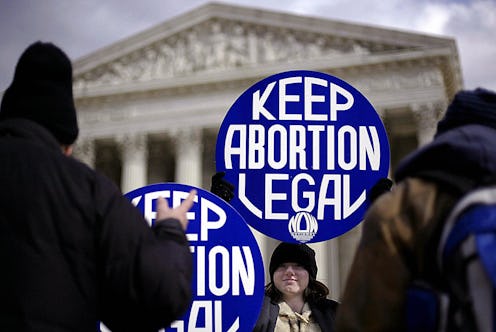News
Why Abortions Are Declining Depends On Who You Ask
There's one thing pro-choice and pro-life advocates can finally agree upon: There are less abortions happening now than there were 40 years ago. According to a new survey from the Associated Press, the abortion rate has dramatically declined by 12 percent nationwide since 2010. That's a huge win for both sides of the abortion debate, but the reasons for the drop really depends on who you ask.
The AP survey took data from 45 states whose health departments maintain records on abortion numbers (not included are California, Maryland, New Jersey, New Hampshire, and Wyoming). Nearly all showed major drops in abortion rates, with only two states, Louisiana and Michigan, with significantly increased rates. Both saw their abortion rates jump 18.5 percent, though that was largely attributed to women crossing state lines because their own states had limited abortion access.
In 2011, the U.S. abortion rate reached its lowest level since 1973 with 16.9 abortions per 1,000 women aged 15 to 44, according to the Guttmacher Institute. In case you need a refresher, that would be the same year of the Supreme Court's landmark Roe v. Wade decision, which said the federal government could not interfere with a woman's right to have an abortion before a fetus could live outside her womb (a timeframe generally placed around 24 to 28 weeks). Opponents to the ruling long pointed to this decision as for why abortion rates jumped, peaking at 29.3 abortions per 1,000 women in 1980, but the latest numbers might finally put that theory to rest.
Guttmacher's study didn't specifically give its reasons for the lower abortion rate, but determined it was more a symptom of declining pregnancy and birth rates as a whole. While the overall drop in teen pregnancy has had a significant impact on abortion rates, what else led to the serious decline is up for debate. Pro-choice advocates say improved sex education and the accessibility of affordable and effective contraception — which includes free birth control under the Affordable Care Act — have helped limit the number of unplanned pregnancies. But pro-life groups argue women's attitudes have changed in recent years as more choose not to terminate their pregnancies and increased state restrictions on abortions prove effective.
Restrictive abortion bills have been on the rise in state legislatures, with more than 300 regulations proposed in 45 states just in this year alone, according to The New York Times. Last Thursday, North Carolina Gov. Pat McCrory said he intended to sign an anti-abortion bill that would require a woman to wait three days after speaking with a doctor before she can have an abortion (the state's current waiting period is one day). A proposed measure in Wisconsin would ban all abortions after 20 weeks, even in cases of rape and incest.
But according to the AP, anti-abortion legislation appeared to have no correlation with dropping abortion rates:
Several of the states that have been most aggressive in passing anti-abortion laws — including Indiana, Missouri, Ohio, and Oklahoma — have seen their abortion numbers drop by more than 15 percent since 2010. But more liberal states such as New York, Washington and Oregon also had declines of that magnitude, even as they maintained unrestricted access to abortion.
There are very few things that perform uniformly across the board in this country, and the drop in abortion rates should be welcomed by both pro-choice and pro-life advocates, regardless of who deserves the credit. But keep this in mind: Accessibility to abortion doesn't create the need for one. That is rooted far before an unplanned pregnancy actually happens, a time when education leads to awareness and contraception helps with prevention.
Image: Getty Images (1)
